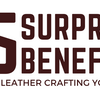Chrome Tanned vs. Vegetable Tanned Leather, Explained

When shopping for leather, there seems to be quite a handful of choices we should decide on.
There is the question of color and texture. But more frequently, leather enthusiasts have to choose between chrome-tanned and vegetable-tanned leather.
What’s the difference between the two? Is there a great advantage of one from the other?
Chrome-tanned and leather-tanned leather are two of the most popular types of leather you can easily purchase today. While there are more kinds you can choose from, most leather enthusiasts would highly recommend narrowing down your massive choices to just the two.
Their versatility and durability when it comes to applications make them such forces to be reckoned with. Both offer their own advantages and disadvantages, making preferences and experience the ultimate deciding factor at the end of the day.
To give you a fuller insight of their differences and why you should get one over the other, we've come up with a way to put the spotlight on each of these leather types.
This article will let you in on both leather types and the factors we should all consider when choosing which one to work with.
Table of Contents
Chrome Tanned Leather: The New, Quicker Way

Arguably the one that started it all, chrome-tanned leather used to be the sole golden standard of what leather should be. While there is a lot of debate about the best texture, natural grain leather remains to be a popular choice among beginner leathercrafters and even expert enthusiasts.
When it comes to tanning, chrome is relatively the new kid on the block. It dates back to the 1800s, which sure sounds like it has been here forever. However, when compared to vegetable tanning, which is said to be present for thousands of years already, it appears to be the newer, more modern approach.
Its invention is mostly due to man's search for a faster way to produce tanned leather still boasting of quality. Despite the fast-tracked tanning process, chrome tanning yields one of the best quality tanned leather you can get yours hands on today.
Chrome tanning is known for being the quicker method of processing leather. Its discovery was thanks to leather tanners’ quest to make the process easier and cheaper. Instead of spending two long months in vegetable tanning, they only had to wait for a few weeks when working with chromium.
If you're keen on trying chrome tanned leather, you can check out our chrome tanned collection here.
Vegetable Tanned Leather: The Classic One

Vegetable tanning is a natural process where organic materials are used to bring life to leather. It is a long, tedious process where animal hides are soaked in vegetable tannins. The whole process takes about two months, or even longer, depending on the leather’s texture and depth.
Despite the length of the process, vegetable tanning is still widely practiced. Its applications are endless, and the advantages it presents despite the time-consuming process outweigh the efforts needed.
To this day, people still see vegetable-tanned leather to be the lesser evil. There are a lot of misconceptions surrounding this kind of leather. However, the fact remains that vegetable-tanned leather is still one of the highest quality ones you can find in the market today.
What's even better is that with the emergence of leather supply shops, it is now easier to stock up on your leather goods without ever having to sacrifice quality.
What’s the deal?
Both chrome-tanned and vegetable-tanned leather offer a great deal of flexibility and durability. For instance, chrome-tanned leather has waterproofing ability, making it a popular choice for shoes, bags, and other items we use on a daily basis. On the other hand, vegetable-tanned leather is known to be the more flexible type. Its texture can survive pulling and stamping over chrome-tanned ones, which makes it great for just about any leather project you may have in mind.With both types having their own advantages, there is no reason not to try combining them. Leather enthusiasts have found a way for crafters to have the best of both worlds.
There is now such a thing as vegetable retanned leather, where both processes have been used to strike a great balance on the quality and texture of the material.
If you've always wanted to work on vegetable-tanned leather, start from browsing our collection here.
Conclusion
Truth be told, there is no one perfect answer when deciding between chrome-tanned and vegetable-tanned leather. They share the versatility and beauty of genuine leather, just that they achieved their look in different ways.
At the end of the day, it still boils down to your preference and what you’re using it for. Checking finished leather goods and seeing how they perform are also great deciding factors when choosing which one to get.
Whichever you choose to work with, having a go-to leather shop is key to ensure you always have the best quality for your craft. You can check out our leather collection here.





